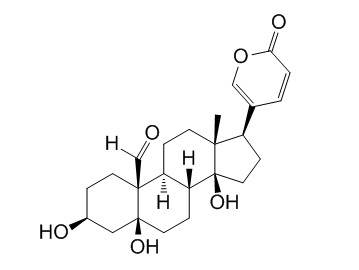Hellebrigenin
Hellebrigenin has anti-hepatoma activities, it induces cell cycle arrest and apoptosis in human hepatocellular carcinoma HepG2 cells through inhibition of Akt. Hellebrigenin exhibites moderate to strong activity against human HL-60, SF-295, MDA-MB-435, and HCT-8 cancer cell strains without hemolysis of mouse erythrocytes.
Inquire / Order:
manager@chemfaces.com
Technical Inquiries:
service@chemfaces.com
Tel:
+86-27-84237783
Fax:
+86-27-84254680
Address:
1 Building, No. 83, CheCheng Rd., Wuhan Economic and Technological Development Zone, Wuhan, Hubei 430056, PRC
Providing storage is as stated on the product vial and the vial is kept tightly sealed, the product can be stored for up to
24 months(2-8C).
Wherever possible, you should prepare and use solutions on the same day. However, if you need to make up stock solutions in advance, we recommend that you store the solution as aliquots in tightly sealed vials at -20C. Generally, these will be useable for up to two weeks. Before use, and prior to opening the vial we recommend that you allow your product to equilibrate to room temperature for at least 1 hour.
Need more advice on solubility, usage and handling? Please email to: service@chemfaces.com
The packaging of the product may have turned upside down during transportation, resulting in the natural compounds adhering to the neck or cap of the vial. take the vial out of its packaging and gently shake to let the compounds fall to the bottom of the vial. for liquid products, centrifuge at 200-500 RPM to gather the liquid at the bottom of the vial. try to avoid loss or contamination during handling.
Nutrients.2019, 12(1):E40
Front Pharmacol.2020, 11:566490.
Drug Dev Ind Pharm.2024, 50(11):938-951.
Mol Divers.2022, s11030-022-10586-3.
J of Pharmaceutical Analysis2020, doi: 10.1016
The Japan Society for Analy. Chem.2017, 66(8):613-617
Int J Mol Sci.2023, 24(15):12397.
Molecules.2016, 21(6)
University of Central Lancashire2017, 20472
Pharmaceutics.2020, 12(9):882.
Related and Featured Products
Toxicon, 2010, 56(3):339-348.
Cytotoxic profile of natural and some modified bufadienolides from toad Rhinella schneideri parotoid gland secretion[Reference:
WebLink]
Cutaneous secretions of toad species are an important source of bufadienolides, compounds that exhibit interesting structural features and biopharmacological properties.
METHODS AND RESULTS:
Here we describe the isolation of bufadienolides from the Brazilian toad Rhinella schneideri parotoid glands secretion, including: marinobufagin (1), bufalin (2), telocinobufagin (3), Hellebrigenin (4), and the atypical 20S,21R-epoxymarinobufagin (5) besides the widespread β-sitosterol (6). Starting from natural bufadienolides four derivatives were prepared: 3β-acetoxy-marinobufagin (7), 3β-acetoxy-bufalin (8), 3β-acetoxy-telocinobufagin (9), and 3β-acetoxy-20S,21R-epoxymarinobufagin (10).
CONCLUSIONS:
The cytotoxic evaluation showed that all natural bufadienolides and their derivatives exhibited moderate to strong activity against human HL-60, SF-295, MDA-MB-435, and HCT-8 cancer cell strains without hemolysis of mouse erythrocytes. The acetylated bufadienolides (7–9) and the epoxide 10 showed lesser peripheral blood lymphocytes (PBLs) inhibitory activity than their precursors, suggesting that chemical modifications on such compounds can play an important role on the modulation of their cytotoxic profile.
Chem Biol Interact. 2014 Aug 5;219:184-94.
Hellebrigenin induces cell cycle arrest and apoptosis in human hepatocellular carcinoma HepG2 cells through inhibition of Akt.[Pubmed:
24954031]
Hellebrigenin, one of bufadienolides belonging to cardioactive steroids, was found in skin secretions of toads and plants of Helleborus and Kalanchoe genera.
METHODS AND RESULTS:
In searching for natural constituents with anti-hepatoma activities, we found that Hellebrigenin, isolated from traditional Chinese medicine Venenum Bufonis, potently reduced the viability and colony formation of human hepatocellular carcinoma cells HepG2, and went on to explore the underlying molecular mechanisms. Our results demonstrated that Hellebrigenin triggered DNA damage through DNA double-stranded breaks and subsequently induced cell cycle G2/M arrest associated with up-regulation of p-ATM (Ser(1981)), p-Chk2 (Tyr(68)), p-CDK1 (Tyr(15)) and Cyclin B1, and down-regulation of p-CDC25C (Ser(216)). It was also found that Hellebrigenin induced mitochondrial apoptosis, characterized by Bax translocation to mitochondria, disruption of mitochondrial membrane potential, release of cytochrome c into cytosol and sequential activation of caspases and PARP. In addition, Akt expression and phosphorylation were inhibited by Hellebrigenin, whereas Akt silencing with siRNA significantly blocked cell cycle arrest but enhanced apoptosis induced by Hellebrigenin. Activation of Akt by human insulin-like growth factor I (hIGF-I) could obviously attenuate Hellebrigenin-induced cell death.
CONCLUSIONS:
In summary, our study is the first to report the efficacy of Hellebrigenin against HepG2 and elucidated its molecular mechanisms including DNA damage, mitochondria collapse, cell cycle arrest and apoptosis, which will contribute to the development of Hellebrigenin into a chemotherapeutic agent in the treatment of liver cancer.



